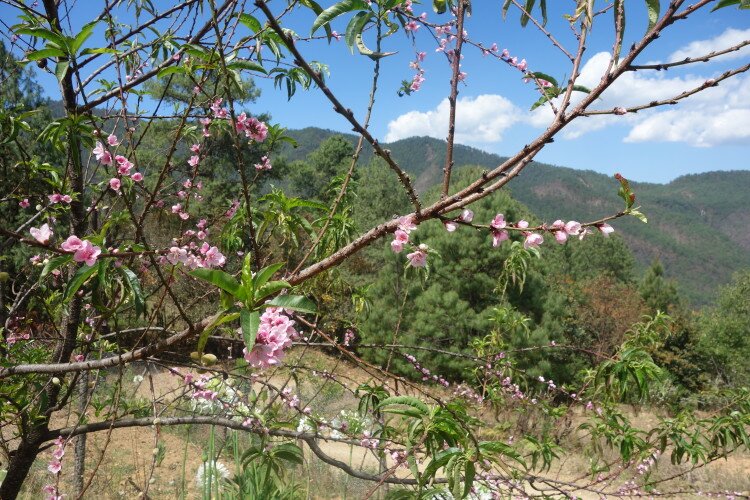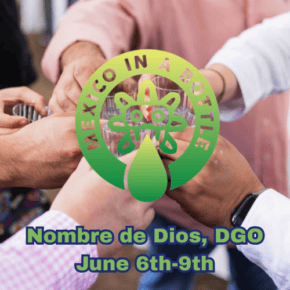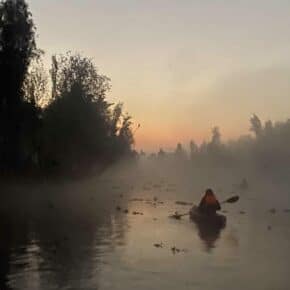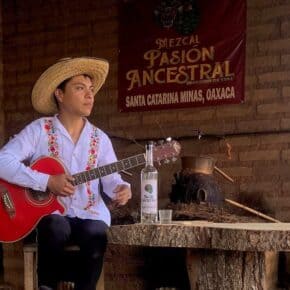This is a cross post from one of our frequent collaborators, Ferron Salniker. You can read her excellent blog Ferronlandia here. This piece was originally published on 4/1/16. You can read the original here.

The morning in Latuvi smelled like fire and smoke, and purple shadows draped over the curves of the Sierra Norte as I looked out from the balcony. At night the trumpet-shaped brugmansia flower was so fragrant it wandered down the stairs towards the cabin. It would be more romantic if the roosters crowed in the morning, but they crowed all the time.
I went to Latuvi, the closest Pueblo Mancomunado, to find some time to write, as the distractions in Oaxaca are endless (ex: today was supposed to be my writing day but I woke up with only three hours of sleep and a hangover so please excuse the typos). The first iteration of the Pueblos Mancomunados started over 400 years ago as a self-governing and cooperative system for a few indigenous communities in the mountains to protect and pool their land and resources. About twenty years ago eight villages launched an eco-tourism program— each village running programs by committee and sharing duties to protect and share their natural environment. Visitors can go to the towns directly or head to an office in Oaxaca to book hikes and bike rides from one village to another with meals, activities, and lodging along the way.
In Latuvi, about 50 km from Oaxaca and 2,450 meters above sea level, the cabins overlook the mountains. A gazebo with four hammocks and a fire pit sits at the bottom of the stairs and the main place to eat is right next door. The cook is a hilarious woman named Martha who busts out simple food with pretty limited ingredients (“we got quesadillas….and quesadillas,” she announced when I came in for dinner). There’s one main road through the town and you’ll meet most of your neighbors taking care of their chickens, cutting wood, or hanging outside of their houses walking down it.
 I think most people just pass through and relax on their way trekking to another town, but you can also learn how to make pulque and tepache, take a temazcal, and learn about traditional medicine. Naturally, as I am a procrastinating city girl who doesn’t know what the fuck to do with silence and spare time, I did them all. Here’s my experience with each one.
I think most people just pass through and relax on their way trekking to another town, but you can also learn how to make pulque and tepache, take a temazcal, and learn about traditional medicine. Naturally, as I am a procrastinating city girl who doesn’t know what the fuck to do with silence and spare time, I did them all. Here’s my experience with each one.
The Temazcal
A temazcal is a traditional purification ceremony most commonly seen in central and southern Mexico. In Latuvi, the temazcal was at the home of Albina Garcia Cruz. Walking up to her house I ran into a family of the cutest grazing goats and then got a little startled as they groaned at me while I was admiring a peach tree’s pink blossoms (lots of fruit trees here).
Albina’s grandmother was a curandera (a community healer), and Albina studied agriculture and community development, so she has a unique background. She has three kids: 5, 13 and 19, and the oldest helps out with the temazcal process when not studying engineering in Oaxaca city. The youngest, Jose, in loafers and jeans, was shaving the rust off his bike when I arrived so that he can paint it bright blue. Most of the kindergarteners I’ve hung out with are still trying to figure out how to use scissors.
Before the temazcal Albina provides a limpia, which contrary to what I heard, was not getting whacked with branches. It’s more like a rubdown with a bundle of fresh herbs wet with an herb extraction. A limpia is supposed to remove bad energy before you get into the temazcal. It smelled like rosemary and mint.
The temazcal is like a sweat lodge with an aromatic vapor, heated up at the visitor’s preference with an herb-infused water. Albina said that it symbolizes a womb: a space for rebirth, to consider how you have mistreated your body and spirit, sweat that maltreatment out, and emerge anew. You can stay in for however long you need, I stayed in for about 50 minutes (it’s been a long week of mezcal) and there was enough room to do some yoga (California girl, sorry not sorry.) It’s dark and meditative, and she gave me a lukewarm lemon tea to keep hydrated.
Afterwards she gives a massage with an apple salve. The massage was not hard but not annoyingly soft, and her 19 year old son helps with them too when there is a crowd (to the ladies’ delight who came in after me).
Traditional Herbal Medicine Lesson
The next morning Albina walked me around her property showing me which plants are used to cure what ailments. “The most important thing is that you believe they’ll work,” she said. “If you don’t even the medicine the doctor gives you won’t work.”
She still uses most of these plants in her diet just like she did growing up, but says her kids are much more resistant (although Jose said he ate some snake the other day so not sure what resistant means). There’s another woman using plant-based medicines in town that most people go to if they’re sick, while Albina mostly helps tourists.
Here are some of the most plant uses she told me about, some of them are planted and others are wild. She uses them for teas, baths, and sometimes to place on a wound. Rarely are they eaten raw, unless for a specific immediate reaction (something to make you vomit for example). I plan on keeping a diagram with me at all times in the Oaxacan boondocks, as I have many-a-time been sick with nothing but a sprite bottle of mezcal from the country store to offer any relief.
Pulmonaria- Grows on trees, used for cough and the flu.Simonillo- Super bitter flower that helps with indigestion, and can make you vomit. Or if you take a bite while hiking it’s so bitter it will help to produce saliva.
Local weeds- She uses the whole plant, even the roots to mix with other herbs to help diharreaha and vomiting. I kinda wanted to pick a bunch and sell them in the zocalo.
Membrillo- An acidic fruit eaten raw for stomach infections.
Palo Aile- (spelling?) Used in the herbal water in temazcals, especially after a woman has a baby. The trunk is used for crafts in neighboring towns.
Madrone- Used to help women stop producing milk. The leaves are put on the nipples with a wrap. She said this works so well, she had trouble producing milk for her youngest child.
Heno- A beautiful weby plant used for decoration during Christmas time, but is also used for coughs.
Siempre Vida- She grills this and removes the liquid for just two eye drops when eyes are infected or irritated.
Calendula- Flowers used for the skin, cough, fever.
Pulque and Tepache
I’ve never been a big fan of pulque, but here it was light and not vicious at all, almost like a super sour kombucha. Pulque here is made by Evelia Marcos Santiago and her family. Her dad wakes up every morning at 4 a.m. and walks to get the agua miel, cutting the spikes off one of the arms of the agave and extracting the liquid. He’s back to their house by 6 a.m. It ferments using a small piecetimbre wood for 20 days. Tepache is just pulque with panela, a sweetner, which makes it much more drinkable. Either way it’s very low in alcohol content, and is still the favored drink here over beer and definitely over mezcal.Planning a Trip
To get more information visit Expediciones Sierra Norte in Oaxaca city, where you can make reservations. There’s a range of options: you can just get info and head up there directly, you can make a reservation and figure out your own transportation, or you can let them book everything, including your transportation. It’s definitely a little cheaper to travel there yourself and book directly once you arrive, I was super tired of planning and didn’t feel like taking a bunch of different buses so I had them pick me up. If just going for 24 hours, Latuvi is a nice option that’s only an hour and a half away.
A note for female solo travelers: It’s cheaper to share a cabin, and when I asked if the cabins were organized by gender, the woman at the office said yes. That wasn’t the case, and while the cabin ended up being full with all kinds of people (there are three bunk beds), if it’s during a slow season I would think it could be a little unnerving to end up in a cabin with a rando dude or dudes.
A note for people who might be inclined to take a cooking class: I heard some people were taking a cooking class and I felt a little bad for them. The ingredients in Latuvi were pretty limited and the food was fine, but with all the amazing chefs and cooking classes in Oaxaca I think you would learn a lot more in the city.































Leave a Comment